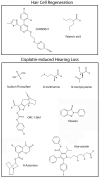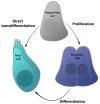Hearing loss: The final frontier of pharmacology
- PMID: 35599339
- PMCID: PMC9124819
- DOI: 10.1002/prp2.970
Hearing loss: The final frontier of pharmacology
Abstract
Despite a prevalence greater than cancer or diabetes, there are no currently approved drugs for the treatment of hearing loss. Research over the past two decades has led to a vastly improved understanding of the cellular and molecular mechanisms in the cochlea that lead to hearing deficits and the advent of novel strategies to combat them. Combined with innovative methods that enable local drug delivery to the inner ear, these insights have paved the way for promising therapies that are now under clinical investigation. In this review, we will outline this renaissance of cochlear biology and drug development, focusing on noise, age-related, and chemotherapy-induced hearing dysfunction.
Keywords: cochlea; hair cell; hearing loss; neurotrophin; ototoxicity; regeneration; synaptopathy.
© 2022 Otonomy, Inc. Pharmacology Research & Perspectives published by John Wiley & Sons Ltd, British Pharmacological Society and American Society for Pharmacology and Experimental Therapeutics.
Figures





References
Publication types
MeSH terms
LinkOut - more resources
Full Text Sources
Other Literature Sources
Miscellaneous

